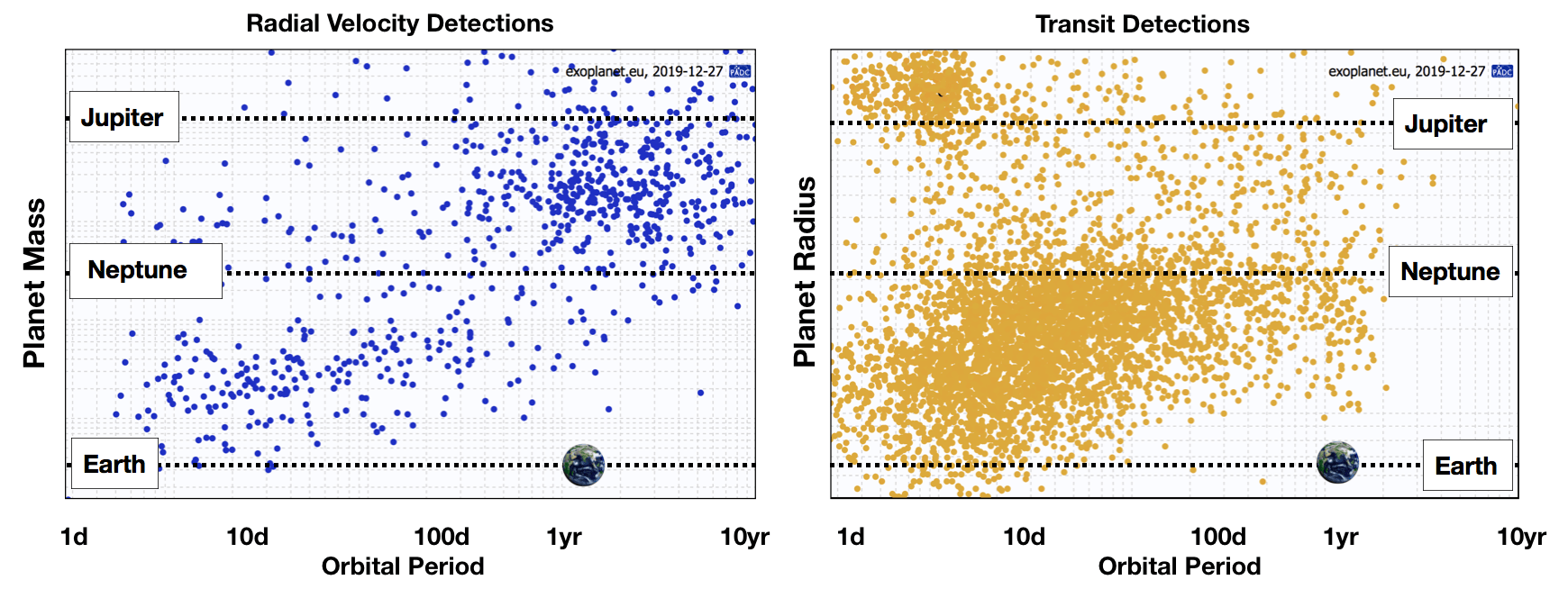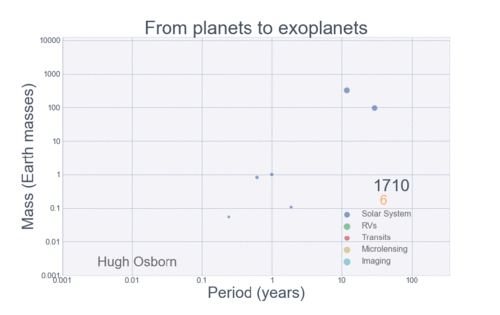10.7 Explanenet统计
章节大纲
-
Exoplanet Statistics
::Explanenet统计Now that exoplanets have been detected, we can take stock of the types of planets that have been found. The Figure below summarizes the radial velocity detections (left) and transit detections (right). The radial velocity detections provide mass (M sini) and orbital period while the transit detections yield planet radius (relative to the radius of the star) and orbital period. Neither method has been successful at detecting planets similar to Earth, and this is believed to be the result of poor sensitivity for the methods at the mass (or size) of Earth and the orbital period (or semi-major axis). An Earth analog would only induce a reflex velocity of 9 cm/s in a solar mass star and the transit probability falls off with increasing semi-major axis .
::由于探测到了外行星,我们可以对已发现的行星类型进行评估。下图概述了辐射速度探测(左)和中转探测(右)的情况。辐射速度探测提供了质量(Msini)和轨道周期,而中转探测则产生行星半径(与恒星半径相对)和轨道周期。这两种方法都无法探测到与地球类似的行星,这据信是地球质量(或大小)和轨道周期(或半主轴)方法敏感度差的结果。地球模拟只会导致太阳质量恒星的反射速度为9厘米/秒,而半主轴的反射概率随着增加而下降。Exoplanet detections with radial velocity measurements (left) and transit data (right). What information about planet formation can you glean from the distribution of detected exoplanets?
::使用辐射速度测量(左)和中转数据(右)探测外白网。你能从所检测到的外平面分布中搜集到有关行星形成的信息吗?For radial velocity observations, at least one orbital period must be observed. Radial velocity surveys have been ongoing for almost 20 years, but observers tend to be impatient (it is hard to get tenure if it takes 10 years to make a discovery), and as measurement precision has improved, the focus on detecting Earth analogs has become more intense. The amplitude of the radial velocity (RV) signal depends on (1) the mass of the planet, (2) the mass of the star, and (3) the orbital period. Higher-mass planets or lower-mass stars produce larger radial velocity signals. The RV amplitude decreases with increasing orbital period (or increasing semi-major axis). The diagonal distribution of RV-detected planets reflects some of the observational incompleteness of this method. If RV surveys are to detect Earth analogs, the precision of this method will need to substantially improve.
::对于辐射速度观测,至少必须观察一个轨道周期。辐射速度调查已经持续了近20年,但观察者往往不耐烦(如果需要10年时间才能发现,很难获得使用权),而且随着测量精确度的提高,对探测地球模拟的侧重已变得更加密集。辐射速度信号的振幅取决于(1)行星的质量,(2)恒星的质量,(3)轨道周期。高质量行星或低质量恒星产生更大的辐射速度信号。RV振幅随着轨道周期的延长(或半主轴的扩大)而下降。RV探测到的行星的对角分布反映了这一方法的一些观测不完全性。如果RV勘测是为了探测地球模拟,那么这一方法的精确性将需要大大改进。For transit observations at least 3 orbital periods must be observed. The NASA Kepler mission was repurposed after 4 years. However, very few planets with orbital periods longer than about 100 days will transit because the probability of crossing the disk of the star falls off with orbital period (or semi-major axis). Because of this geometric bias, it is unlikely that transit missions will detect many Earth analogs.
::对于至少3个轨道期间的中转观测,必须观测到至少3个轨道期间。美国航天局开普勒飞行任务在4年后进行了重新定位。然而,轨道期间超过约100天的行星很少会过境,因为通过恒星磁盘的概率随轨道期间(或半主轴)而下降。由于这种几何偏差,过境飞行任务不可能探测到许多地球模拟。The Figure below summarizes the history of planetary discovery.
::下图概述了行星发现的历史。A history of exoplanet discovery. First, the detection of planets in our solar system. Beginning in 1995, there was a burst of detections with the RV method, and after the launch of Kepler an explosion of new planets.
::首先,探测太阳系中的行星。从1995年开始,用RV方法探测出一股爆炸,在开普勒发射后,又爆发了新行星的爆炸。Each detection method is sensitive to a limited region of parameter space, so we cannot expect that planets would be discovered outside of the detectable region. However, there are some areas in the exoplanet parameter space where planets should have easily been detected. One region is the swath of parameter space for transiting planets with radii between Neptune ( ) and Jupiter ( ). The lack of planets in this region must represent a real paucity of planets.
::每种探测方法都对有限的参数空间区域敏感,因此我们无法指望在可探测区域之外会发现行星。然而,在外行星参数空间的某些区域,行星应该很容易被探测到。一个区域是海王星(4R)和木星(10R)之间具有半射线的行星的中转参数空间。该区域缺少行星必须代表行星的实际稀少。There is also a large clump of planets similar in size to or slightly larger than Jupiter, but with orbital periods shorter than 10 days among the transit detections. Some Jupiter-mass planets in short-period orbits have been found, but the RV detections seem relatively deficient in these objects. This overabundance in short-period gas giant planets is the result of transit surveys of hundreds of thousands of stars with insufficient sensitivity to detect planets much smaller than Jupiter.
::还发现了一些短期轨道上的木星行星,但这些物体的RV探测似乎相对不足。 短期气体巨行星的这种过度富集是数十万颗恒星进行过境勘测的结果,这些恒星对探测比木星要小得多的行星的敏感度不足。The next Figure projects a hopeful view of what discoveries should come next.
::下图对接下来的发现充满希望。The future of exoplanets, from 2017 to 2035. Planned missions should fill in the parameter space of exoplanets.
::从2017年到2035年,计划派遣的飞行任务应填充外行星的参数空间。The TRAPPIST-1 system
::TRAPPIST-1系统European astronomers started a program to search for exoplanets using ground-based transit photometry. Their project, with the slightly contrived name: “Transiting Planets and Planetesimals Small Telescope” or TRAPPIST, targeted M dwarf stars that are about one tenth the size of the Sun. The transit signal is proportional to the cross sectional area of the planet divided by the cross sectional area of the star, so the advantage of looking at small stars is that the transit signals from smaller planets are stronger. In 2015, three planets were detected with this survey around a star that the team renamed TRAPPIST-1 (catchier than the original catalog name for this star, 2MASS J23062928-0502285). , four more planets were discovered around this same star, bringing the total to seven planets orbiting TRAPPIST-1. All of these planets orbit at a distance that is smaller than the distance from the Sun to Mercury in our solar system and are similar in size to the rocky terrestrial worlds.
::欧洲天文学家启动了一个利用陆基中转光度测量来搜索外行星的程序。 他们的项目, 使用略微构思的名称 :“ 转换行星和行星小望远镜” 或TRAPPIST , 目标是与太阳大小大约十分之一的M矮星。 中转信号与星体的跨区面积成正比, 因此观察小行星的优势在于小行星的中转信号更强大。 2015年, 通过这次调查, 发现三个行星围绕一个星体, 星体小组更名为TRAPPIST-1( 比该星的原始星体名称2MASS J230628-052285) 的星体周围又发现了四个行星, 使总行星在TRAPPIST-1轨道上运行的行星达到7个。 所有这些行星的轨道距离都小于太阳系从太阳到水星的距离, 并且与岩石地球世界的大小相似 。
A comparison of the sizes of planets in the TRAPPIST-1 system to the familiar solar system planets.
::将TRAPPIST-1系统中行星的大小与熟悉的太阳系行星作一比较。One reason that this is an intriguing system is that TRAPPIST-1 is barely a star. It has about 8% the mass of the Sun. If it were a bit smaller, TRAPPIST-1 would not even be able to fuse hydrogen and emit light. Because of its very low mass, the star burns its small reserves of hydrogen very slowly. While the Sun ends its life in another 5 billion years, TRAPPIST-1 will fuse hydrogen into helium for another 100 billion years.
::这是一个令人感兴趣的系统,其原因之一是TRAPPIST-1只是一颗恒星。它有大约8%的太阳质量。如果它小一点,TRAPPIST-1甚至无法将氢融为一体并发射光。由于它的质量非常低,恒星的少量氢储备燃烧得非常缓慢。当太阳在50亿年中结束生命时,TRAPPIST-1将再把氢融为1 000亿年的氦。Another reason that astronomers were excited about TRAPPIST-1 is that at least three of the seven planets orbit at a distance from the low luminosity star where the temperature is just right for liquid water. If there are three habitable worlds around the TRAPPIST-1 star and if technological civilizations evolve on any of these planets, there will be a powerful incentive to build spaceships that travel to these neighboring worlds.
::天文学家对TRAPPIST-1感到兴奋的另一个原因是,七颗行星中至少有三颗在距离低光度恒星的距离内运行,那里的温度正好适合液态水。 如果在TRAPPIST-1号恒星周围有三个可居住的世界,如果技术文明在这些行星中的任何一颗上演变,那么建造飞往这些相邻世界的宇宙飞船将有很大的动力。The orbits of the seven TRAPPIST-1 planets are close to resonance, meaning that the ratio of the orbital periods are close to integer values. Planet e is in a 6-day orbit and planet g is in a 12-day orbit; planet f is in a 9.2-day orbit and planet h is in an 18.7-day orbit. This regularity in the orbits is similar to harmonics in music and inspired a musical that was mapped to the orbits of the seven TRAPPIST-1 planets.
::7个TRAPPIST-1行星的轨道接近共振,这意味着轨道周期的比率接近整数值。e行星在6天的轨道上,g行星在12天的轨道上;f行星在9.2天的轨道上,h行星在18.7天的轨道上。轨道上的这种规律性类似于音乐中的调音,并激发了一种音乐,它被映射到7个TRAPPIST-1行星的轨道上。
A comparison of the TRAPPIST-1 planetary system with the solar system. Seven planets (b,c,d,e,f,g,h) orbit at a distance from TRAPPIST-1 that is closer than Mercury is to the Sun. But, this star puts out such low energy that it is cool enough for at least three of these planets to be "habitable" worlds.
::将TRAPPIST-1行星系与太阳系作比较。七颗行星(b,c,d,e,f,g,h)的轨道距离TRAPPIST-1的距离比Mercury更接近太阳。但是,这颗恒星释放出如此低的能量,以至于它足够冷却,至少能让其中三个行星成为“可居住”的世界。


